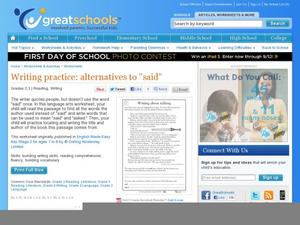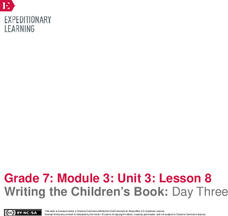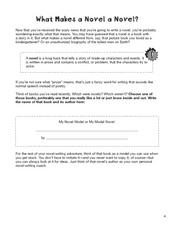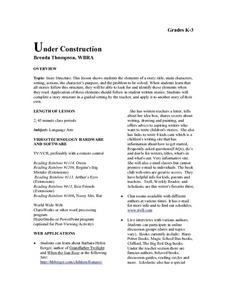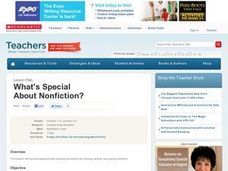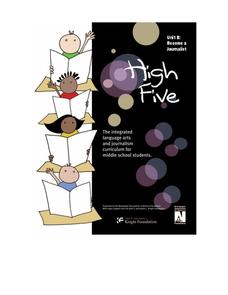Hood River County School District
Text Structure: Features and Organization
Teach learners how to interact with both fiction and non-fiction text with a packet of activities and worksheets. After looking over text structure and the difference in text features between different types of writing,...
Curated OER
Writing a Screenplay
It's time to make a movie! Kids follow 15 steps to take their movie ideas from concept to script, following clear examples. The resource includes creative ways to guide learners into developing a few words and concepts into fully...
Art Institute of Chicago
African Myths and Stories
Young historians discover African stories associated with a royal altar tusk from the Kingdom of Benin in Nigeria, read myths illustrated on the tusk, and write a story about the life of an oba using figures depicted on the tusk.
Poetry4kids
How to Write a Cinquain Poem
A lesson challenges scholars to create a cinquain poem. Writers begin by choosing a topic and brainstorm details, then compose their original poem making sure to count syllables.
Curated OER
Identifying Setting: Expository Writing
Your class can take turns describing a well know location or setting without giving its name, and the rest of the class can try to identify the location, based on the details given. They chart the elements that helped in the...
Positively Autism
"Visiting Family at Christmas" Social Skill Story
Holidays bring their own special joys and stresses. Prepare learners on the autism spectrum for Christmas family get togethers using this social story that not only lets them know what may happen, but also details how they should...
Positively Autism
"What to Expect at Christmas" Social Skill Story
Holidays are less stressful if we know what to expect. Here's a social skills story that prepares learners with autism for the change in routines that holidays bring.
Curated OER
Writing About Talking
The story of King Arthur is a fascinating one, and this retold excerpt offers an excellent example of narrative word choice in a dialogue. Learners read the text and examine the way the author uses synonyms for said. They write down...
EngageNY
Writing the Children’s Book: Day Three
Illustrations are a key feature of children's books. Using the resource, pupils learn about adding illustrations to their children's books. Next, as they complete their storyboards and work on their second drafts, they consider their...
Curated OER
What Makes a Novel a Novel?
As your authors prepare to write a hypothetical novel, they need all the inspiration they can find! Using a book they have already read (and enjoyed), learners complete a literary analysis by filling in eight short-answer...
Curated OER
Under Construction
Young readers examine the elements of story structure that are included in all stories. They include these elements in their own written pieces. This phenomenally-designed plan has everything you need to easily implement it in your...
Curated OER
What's Special About Nonfiction?
Students examine the difference between nonfiction and fictional writing. They identify the characteristics of nonfiction literature and examine how a nonfiction textbook organizes information.
Curated OER
Creating a Newspaper
Get the scoop with a fun, engaging newspaper project. After analyzing the parts of a newspaper, including the headline, subtitles, and pictures or images, young journalists get to work by writing their own stories in a newspaper article...
Scholastic
Defining Conflict Using "The Interlopers"
Feeling conflicted? Work out those issues with a language arts instructional activity on internal and external conflict. Using "The Interlopers" by Saki, class members identify the conflicts between the characters before writing...
Curated OER
Editing Marks, Part 1
Dander from the show Twisted Whiskers and characters from My Little Pony are featured in this three part lesson that explores using story pyramids to scaffold ideas, adding sensory details to enrich writing, and editing using common...
Houghton Mifflin Harcourt
Alexander Graham Bell
Study the features of nonfiction text with a set of comprehension and analysis materials. Readers learn about Alexander Graham Bell with questions about the text, writing prompts, and proofreading activities.
Ziptales
The Pied Piper of Hamelin
Scholars create a brochure that features three aspects of the poem "The Pied Piper of Hamelin." The program details information about Robert Browning, the poem's setting, and its events.
Curated OER
The Rest of the Story
Third graders make predictions about the story "The True Story of the Three Little Pigs" based on background knowledge. They read the story, stopping to verify or reject predictions. They write their own opinionated fairytales.
Online Publications
Become a Journalist
Explore the newspaper as a unique entity with a detailed and extended unit. The unit requires learners to consider the newspaper's role in democracy, think about ethics, practice writing and interviewing, and examine advertising and news...
Curated OER
Humorous Story Featuring Clowns
Students write a funny story about clowns. In this humorous story writing lesson, students determine how to develop a setting, use clowns as characters, and how to write a humorous story with a happy ending. They follow the study guide...
Curated OER
Journal Writing Idea - Pets
Carve out some time for your youngsters to write in their journal. Today, they write a story about pets. They learn the value of a journal and how to keep up with it, and they enhance story development by planning their story before...
Curated OER
Feature Stories
Students are taught the basics of writing a feature story. They choose a topic for research. Students use the library and internet research skills to investigate their topic. They proofread their own writing or the writing of others,...
Curated OER
Using NewsHour Extra Feature Stories
Learners read NewsHour Extra's feature story and answer the questions on the reading comprehension handout.
Curated OER
My Writing Portfolio
Emerging writers create a portfolio showcasing various writing formats. They discuss Alexander and the Terrible, Horrible, No Good, Very Bad Day. They observe the key features of picture books and then create their own book to add...







